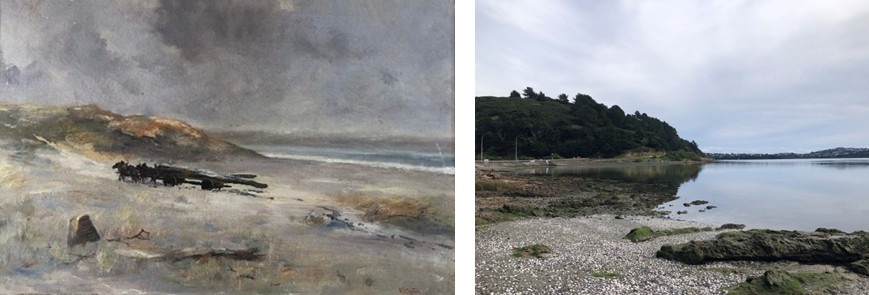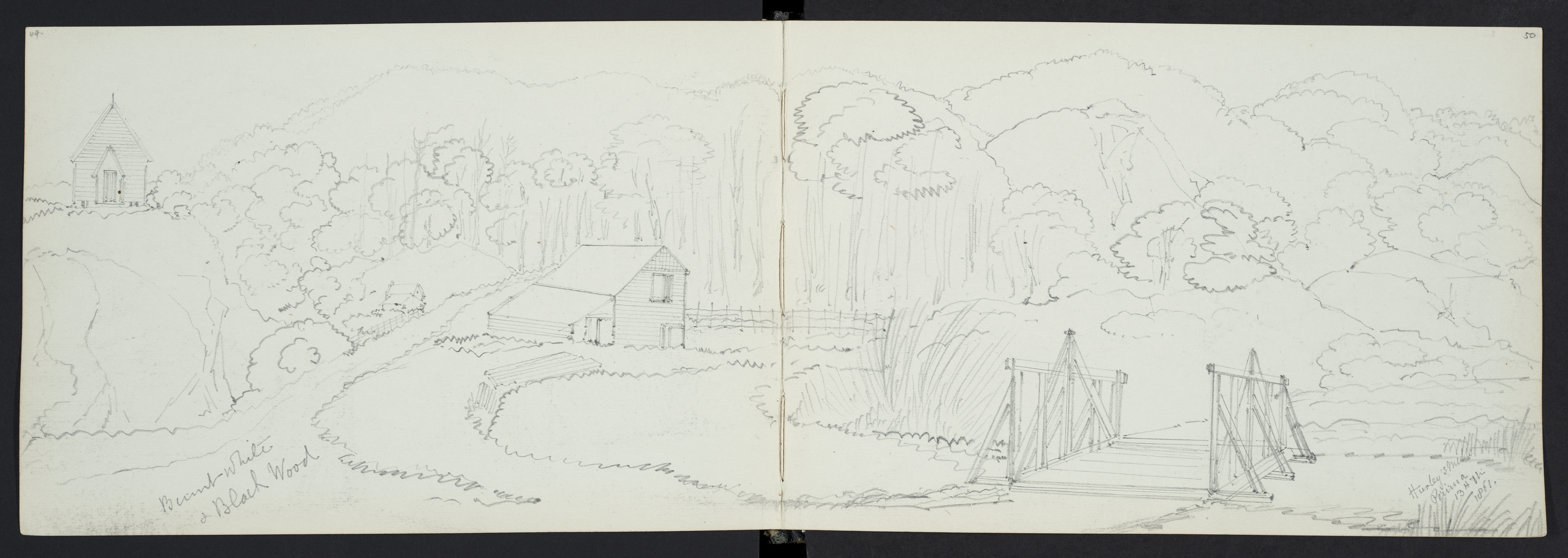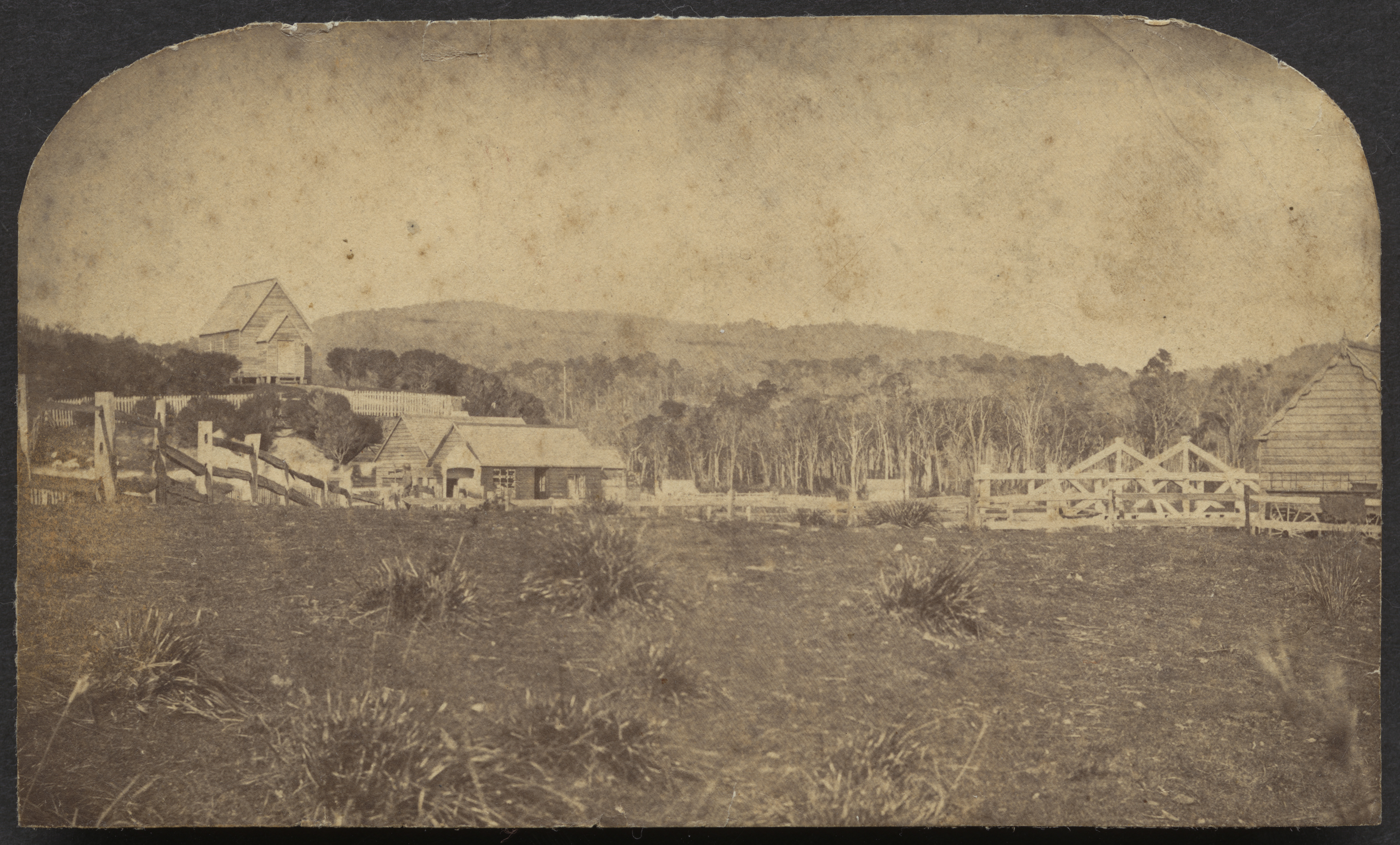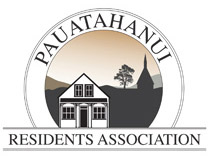WH Carter Painting
The Painting
The painting was created by William Henry Carter in 1907 and titled Horses Pulling Logs Across the Beach by Helen Reilly in Pāuatahanui – A Local History.1
Both of the artist’s grandfathers—Edward Charles Carter (paternal) and Joseph Hurley (maternal)—were among the earliest sawmillers in Pāuatahanui, establishing a sawmill together in 1859. By the early 1900s, when the painting was completed, most of the millable timber had been cleared from the surrounding hills. The work likely depicts a denuded hillside to the west of Wai-o-Hata (Duck Creek), where one of the two Carter–Hurley family sawmills once operated2.

This may be the same view.
The long logs shown may have been destined for use as spars—a valuable commodity during the age of sailing ships. Timber from Pāuatahanui was in high demand throughout the Wellington region for construction and furniture making, including for the building of Wellington’s first Anglican cathedral, Old St Paul’s3.
The painting remained with the Carter family until it was gifted to the Pāuatahanui Residents Association in 2024. Originally owned by Charles Adolphus Carter—cousin of the artist and son of Edward Carter (b. 1840, d. 1891)—it was passed down through generations4 and donated by Charles’ granddaughters, Colleen, Kate, and Ann Luxton.
The Artist
William Henry Carter’s birth was recorded as 24 September 1873, son of William Henry Carter (b1831, d1927) and Sarah Ann Hurley (b1837, d1903)5.
Adrienne Nicholls, great-granddaughter of the elder William Henry Carter, has provided the following information:- "WH Carter Jnr (the artist) was the brother of my grandfather, Herbert. He was born in Karori in 1872. He was very artistic and a dedicated astronomer. His paintings of the night sky and Halley's Comet in 1910 reflected his hobby. The Carter Observatory had many of his works, but these are now thought to have been destroyed. He also exhibited at the Royal Academy. He served in WW1 and died in 1959.”6
William Henry Carter enlisted for service in World War I in 1917 and was briefly posted overseas with the Canterbury Infantry Regiment – C Company (Service Number 45821)7.
He married in 1927 at the age of 53, with the marriage notice recording him as an artist and a member of the New Zealand Academy of Fine Arts8.

Programmes from various art societies show that William Henry Carter Jnr exhibited with the Auckland Society of Arts, the Canterbury Society of Arts, and the New Zealand Academy of Fine Arts in Wellington9.
The Family
Edward Charles Carter operated the Pāuatahanui sawmills with his sons William (the artist’s father), James, Alfred, and Charles10.
Edward Snr died in 1870 and it is believed that he and his wife, Mary Seaman Carter, are both buried in the Pāuatahanui Public Burial Ground11 although in unmarked graves.12

Other family members known to be buried in the Pāuatahanui Public Burial Ground14 are:-
- · Edward Jr. and his wife Mary Ann
- · Charles and his wife Hannah, daughter of one of the original Stace settlers
- · James, who was killed in a logging accident in 1874
Charles and Hannah Carter built Clifton House on the Paremata to Pāuatahanui Road15. Across the road were the local tennis courts—now part of the Pāuatahanui Wildlife Reserve. Older members of the Reserve recount planting trees by breaking through the old tennis court surface.
The Luxton family remember "Mum telling us that her father, Charles Adolphus Carter, (cousin of the artist) recognised the importance of native trees and shrubs, and fenced off an area of his farmland to protect it. That area later became part of the Pāuatahanui Wildlife Reserve."16
Sawmilling
In 1859 Edward Carter Snr and his son William formed a partnership with Joseph Hurley (William’s father-in-law) to operate a sawmill at Pāuatahanui. They leased 25 acres of land from Thomas Hollis Stace in Section 63 near the mouth of the Pāuatahanui Stream and established the sawmill below what is now the Public Burial Ground. A second mill was later built at Duck Creek17.
![Bradey, J. (1926). [Painting based on an 1863 original oil painting by Frank Bradey]. In L. E. Ward, Early Wellington (p. 451). New Zealand Electronic Text Collection, National Library of New Zealand.](/uploads/sites/pauatahanui/files/PDFs/WH Carter Painting/Bradey Painting of Duck Creek sawmill.jpg)
Bradey, J. (1926). [Painting based on an 1863 original oil painting by Frank Bradey]. In L. E. Ward, Early Wellington (p. 451). New Zealand Electronic Text Collection, National Library of New Zealand.
A sketch by Janetta Cookson (below) dated 13 December 1861 shows the mill near the base of the path to the chapel. The old chapel was demolished in 1908, following the consecration of St Alban’s Church on its current site in 189618. Remnants of the path, once the legal access to the Public Burial Ground, remain alongside Paekākāriki Hill Road.

Cookson, Janetta Maria, 1812-1866. [Cookson, Janetta Maria] 1812-1867 :Hurley's Mills, Porirua, 13th Dbr 1861. [Cookson, Janetta Maria] 1812-1867 :Auckland Wellington 1861 1851-1865. Ref: E-340-q-049/050. Alexander Turnbull Library, Wellington, New Zealand. /records/22704610
An early photograph of Pāuatahanui c1860 shows the location of the sawmill below the chapel.

Creator unknown : Photograph of a scene at Pauatahanui, Porirua, Wellington. Ref: PAColl-9471. Alexander Turnbull Library, Wellington, New Zealand. /records/23012114
Advertisements in Papers Past advertising a contract to build the bridge across the Pāuatahanui Stream also describe the mill as being between the stream and the chapel19.

After 3 years the partnership with Joseph Hurley was amicably dissolved with Edward Carter and his sons continuing to operate the sawmills.20

In 1862, the same year that the partnership with Joseph Hurley was dissolved, the sawmill at Pāuatahanui burnt down but it was replaced by another sawmill run by the Carter family.21
Before the Carter family joined him in sawmilling at Pāuatahanui, Joseph Hurley had advertised timber and firewood for sale in local newspapers.22

References
1. Reilly, Helen (2013). Pāuatahanui – A local history (p.53). Pāuatahanui Residents Association
2. Christine Stanley, Pāuatahanui History Group
3. Reilly, Helen (2013). Pāuatahanui – A local history (p.55). Pāuatahanui Residents Association
4. Luxton family email
5. William Henry Carter birth certificate
6. Luxton family email
7. https://www.aucklandmuseum.com/war-memorial/online-cenotaph
8. https://paperspast.natlib.govt.nz/
9. https://findnzartists.org.nz/en/artist/2606/w-h-jnr-carter
10. https://www.findagrave.com/cemetery/2285338/wharerangi-lawn-cemetery
11. Reilly, Helen (2013). Pāuatahanui – A local history (p.234). Pāuatahanui Residents Association
12. https://www.findagrave.com/cemetery/2581972/saint-albans-burial-ground
Note: Although Edward Snr and Mary Carter are listed as being buried at St Alban’s Burial Ground, the first recorded burials there did not occur until 1931. It is therefore assumed that they are actually buried in the Pāuatahanui Public Burial Ground, likely in unmarked graves. According to the Kapi-Mana News (April 14, 1982), a slab from the sawmill was used as a headstone for Edward Carter.
13. https://paperspast.natlib.govt.nz/ Evening Post 27 April 1886
14. https://www.findagrave.com/cemetery/2305484/pauatahanui-burial-ground
15. Reilly, Helen (2013). Pāuatahanui – A local history (p.234). Pāuatahanui Residents Association
16. Luxton family email
17. Reilly, Helen (2013). Pāuatahanui – A local history (p.55). Pāuatahanui Residents Association
18. Reilly, Helen (2013). Pāuatahanui – A local history (p.101). Pāuatahanui Residents Association
19. https://paperspast.natlib.govt.nz/
20. Reilly, Helen (2013). Pāuatahanui – A local history (p.56). Pāuatahanui Residents Association
21. Reilly, Helen (2013). Pāuatahanui – A local history (p.56). Pāuatahanui Residents Association
22. https://paperspast.natlib.govt.nz/
